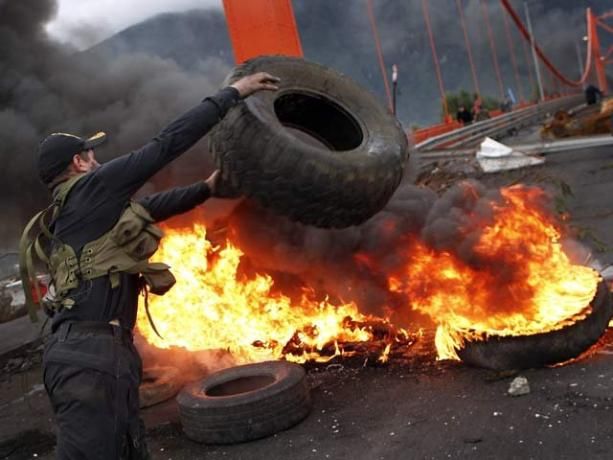
Fuente
In the incineration of tires (rubbers for Venezuelans) and plastic materials the combustion of organic materials is produced generating heat, physical disintegration and chemical disaggregation of the material and the formation of new compounds very toxic for living beings.
The practice of the cement industry of using rubber as fuel and as an object of burning in the street demonstration has been fought by environmentalist sectors for the generation of compounds in the form of gases and ashes that are highly toxic to natural factors in general and to humans in particular, beating the levels of biosafety and sustainability of these activities.
The rubber or tire has a high value or calorific value of 8,300 Kcal/Kg, located below the oil (10,409 Kcal/Kg), but above the coal (7,400 Kcal/Kg). It is because of this characteristic that it has been included in the processes of elaboration of coal as a high value fuel at low cost and easy to obtain and it is also because of this that it breaks the indennity of the asphalt in which it is burned.
In 1880 Charles Goodyear added sulfur at high temperatures in the preparation of tires, which gave him with this process called vulcanization, the current characteristics of these objects. In addition, natural and synthetic rubber (hydrocarbon polymers of polysoprene, polybutadiene, stierobutadiene), steel cord, textile fiber, softeners, catalysts (zinc and magnesium oxide, palladium, rhodium, platinum), antioxidants and carbon black (incomplete combustion of natural gas) are part of the tire. This means that rubbers contain carbon, hydrogen, sulfur, chlorine, iron, silicon dioxide, nitrogen, chrome, nickel, cadmium, titanium and others.

Fuente
The ashes have been shown to contain silicon dioxide, aluminum dioxide, iron oxide, titanium oxide, magnesium oxide, sodium oxide, potassium oxide, sulfates, and sulfur oxide. As for gaseous emissions, they are composed of carbon monoxide and dioxide, sulfur dioxide (in the atmosphere it is converted into sulfur anhydride and causes acid rain), nitrogen oxides, heavy metals (cadmium, titanium), hydrocarbons, chlorocarbons (ozone-depleting CFCs), benzenes, dibenzodioxins (PCDDs) and dibenzofurans (PCDFs) classified as Persistent Organic Pollutants (POPs).
Dioxins (polychlorinated dibenzodioxins or PCDD) and furans (polychlorinated dibenzofurans or PCDF) are highly toxic compounds, physiologically active at very small doses, persistent, accused of being teratogenic (capable of causing congenital malformations) and carcinogenic (cancer of the liver, lung, tongue, mouth, nostrils, thyroid, adrenal gland and skin).
Dioxins in the Vietnam War were used as defoliants (Agent Orange) and countless studies have been conducted relating their effects. These, as well as furans, are water-soluble contaminants capable of passing from one trophic level to another in the food chains to man, even through breast milk.
The Rio Summit in 1992 and the Johannesburg Summit in 2002 exalted the value of shared responsibility and the obligation of social control, especially through environmental NGOs. That is why the sectors that develop rubber or tire burning activities must consider their role as polluters through this practice and the community must actively participate in the design of cleaner technologies and more sustainable practices to avoid damage to our ecosystems and human health.